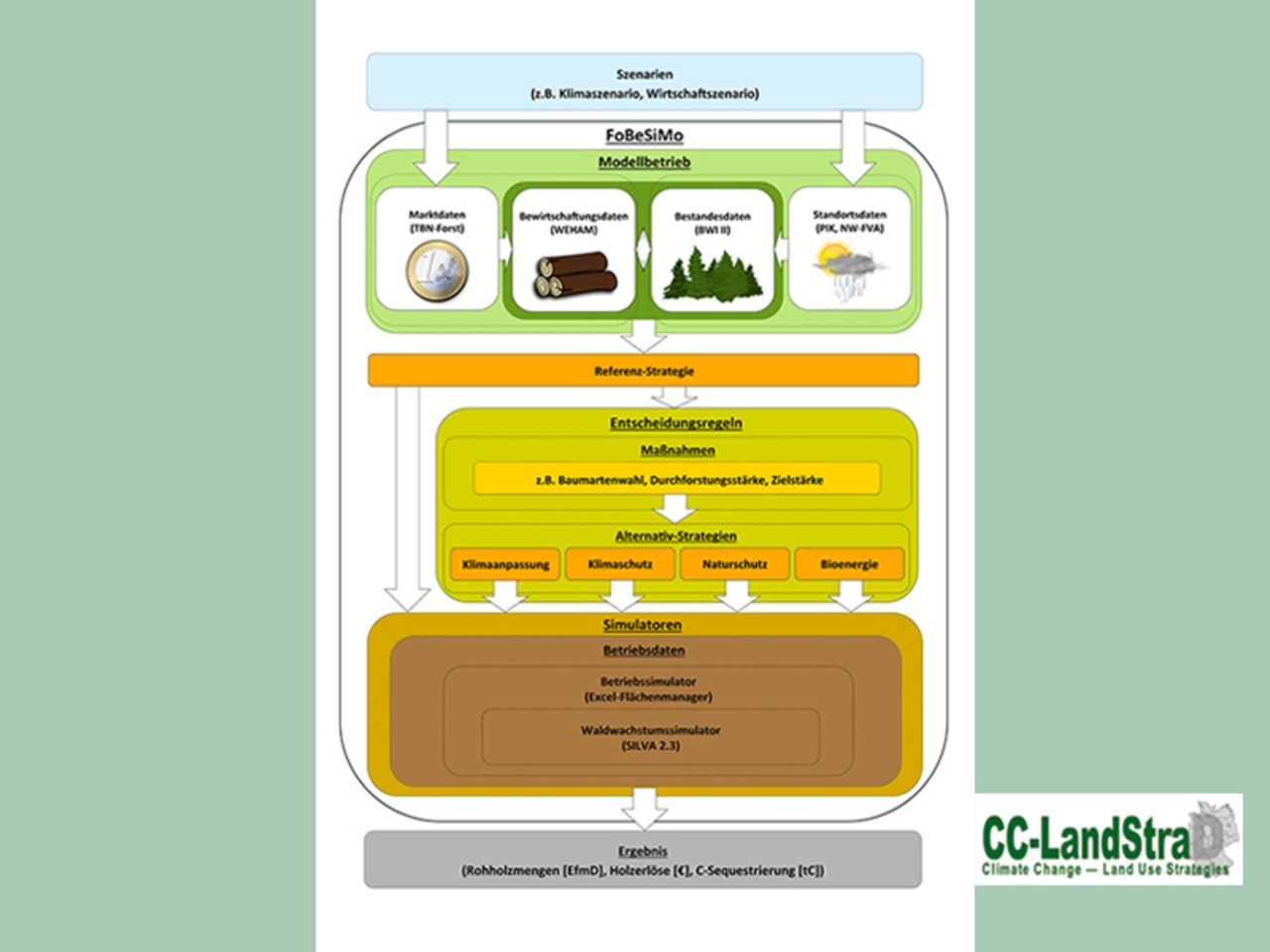Project
CC-LandStraD: Simulation of forest management decisions

Climate Change - Land Use Strategies Germany; Sub project: Modelling of different forest land use strategies under changing environmental conditions
On the one hand, by increasing carbon stored in forest stands and wood products, forestry can contribute to the improvement of the carbon balance (mitigation). On the other hand, possible global warming and the associated changes in growth conditions challenge forestry to adapt its forest management (adaptation). With our research project we analyse economic aspects of both, adaption and mitigation.
Background and Objective
The predicted climate changes, as well as the increasing competition for land areas will have both physical and economic consequences for forestry enterprises. Consequently, changes in tree species selection, in forest management, in the economic success of the enterprise, in wood supply and in carbon storage capacity of forests and wood can be expected. German forestry therefore has to adapt strategically to changing site and economic conditions. In this case, the long-term production periods present a special challenge to forestry. With our economic subproject we aim to determine the effects of changing production conditions on the profitability of German forest enterprises, on the domestic raw wood supply as well as on carbon stored in forest stands and in wood products.
Target Group
Decision-makers from politics, administration and economy
Approach
To solve this economic problem we developed a forest enterprise simulation model. The model enables us to analyse the effects of forest management decisions under changing climatic conditions. Furthermore, we created model forest enterprises in order to simulate and analyse the effects of changing production conditions and the resulting silvicultural adaption measures.
Data and Methods
Our developed forest enterprise simulation model is based on the forest growth- and forest management simulation of the simulator SILVA 2.3 (forest).In order to conduct climate-sensitive simulations, extensive databases had to be adapted to SILVA-structures (e.g., forest inventory, climate and soil data). The model forest enterprises were created based on site, stand, management and market data. Important databases of our research project are the National Forest Inventory, the base scenario of the forest development and timber resource modelling (WEHAM), climate data of the Potsdam Institute for Climate Impact Research (PIK), soil data of the Nordwestdeutsche Forstlichen Versuchsanstalt (NW-FVA) as well as data of Test Enterprise Network (TBN-Forst) of BMEL.
Results
- A constant rise of the temperature by 2 ° C leads to a reduced tree growth in all five investigated strategies.
- In the reference strategy the felling volume continuously increases in the investigation period 2015-2055.
- In terms of felling, the four alternative strategies on average differ only slightly over the period under consideration. However, the temporal structure includes strategy-related differences. The bioenergy strategy as well as the climate adaptation strategy both focus, to varying degrees, on increased timber harvesting, shorter rotation periods and correspondingly reduced stockholding. This leads to high fellings at the beginning of the investigation period and correspondingly lower fellings over the next 40 years of the simulation.
- The contribution margins differ strongly between the strategies. During the investigation period, the climate protection strategy provides the highest average income, followed by the bioenergy strategy, the nature and environmental protection strategy and finally the climate adaptation strategy. In the bioenergy strategy and climate adaptation strategy, the contribution margins are significantly influenced by the high cost of re-establishment at the beginning of the 40 year simulation period.
- The average carbon sink capacity of forests and timber (including material and energy substitution potentials) is highest in the nature and environmental protection strategy and the climate protection strategy. The bioenergy strategy and climate adaptation strategy both have lower capacities. Generally, the simulation period of 40 years should be pointed out, which only partially reflects the effects of forest conversion towards tree species with higher growth rates (e.g., in the bioenergy strategy).
- On average over the simulation period none of the investigated strategies dominates the others in all three outcome measures (wood income, financial income, carbon sink capacity). A decision for one of the strategies can therefore cause conflicts. As the pros and cons of each strategy have different distributional effects regarding managerial interests on the one hand and social interests on the other hand, policy initiatives in favor of one of the strategies may require compensations for forest enterprises.
Thünen-Contact

Involved Thünen-Partners
Involved external Thünen-Partners
- Bundesinstitut für Bau-, Stadt- und Raumforschung (BBSR)
(Bonn, Deutschland) - Institut für ökologische Wirtschaftsforschung (IÖW)
(Berlin, Deutschland) - Leibniz-Zentrum für Agrarlandschaftsforschung (ZALF) e.V.
(Müncheberg, Deutschland) - Potsdam-Institut für Klimafolgenforschung (PIK)
(Potsdam, Deutschland) -
Westfälische Wilhelms-Universität (WWU)
(Münster, Deutschland)
Duration
11.2010 - 10.2015
More Information
Project status:
finished
List of Publications
- 0
Baum S, Conradt T, Dechow R, Elsasser P, Englert H, Ermisch N, Gömann H, Goetzke R, Gottschalk P, Gutsch M, Henseler M, Hoymann J, Köthke M, Kreins P, Lasch-Born P, Suckow F, Wechsung F (2021) Modellgestützte Wirkungsanalysen ausgewählter Maßnahmen und Strategien. In: Gömann H, Fick J (eds) Wechselwirkungen zwischen Landnutzung und Klimawandel. Wiesbaden: Springer Spektrum, pp 143-297, DOI:10.1007/978-3-658-18671-5_4
- 1
Ermisch N, Elsasser P (2013) Betriebswirtschaftliche Analyse von Landnutzungsstrategien im Forst : Enwicklung des forstbetrieblichen Modells FOBEMO. In: Fick J (ed) Wechselwirkungen zwischen Landnutzung und Klimawandel : nachhaltiges Landmanagement in Deutschland: Sachstand und Perspektiven. Braunschweig: Johann Heinrich von Thünen-Institut, p 2

![[Translate to English:] Logo des Bundesministerium für Ernährung und Landwirtschaft](/media/allgemein/logos/BMEL_Logo.svg)